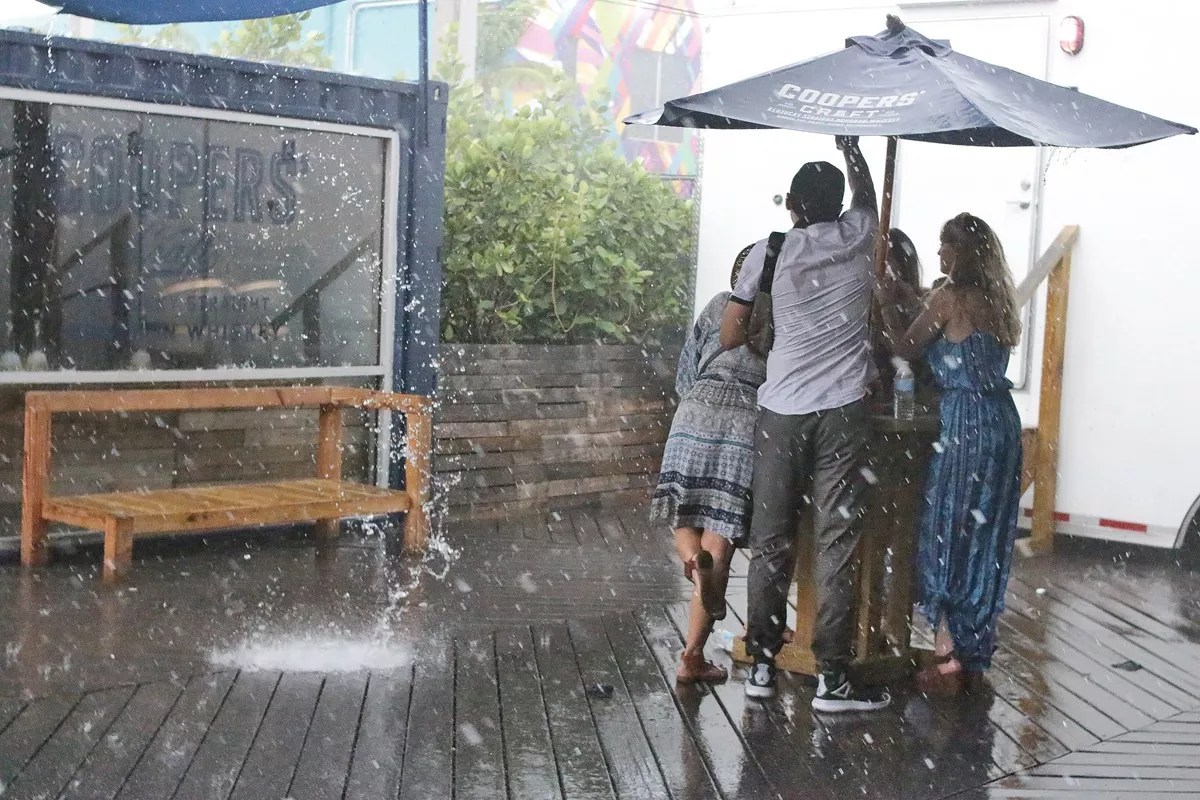
Photo by Michael Campina

Audio By Carbonatix
Miami hasn’t suffered a direct hit from a major hurricane in quite some time, but serious flooding events are becoming distressingly common in the Magic City. Last week, a tropical disturbance came to South Florida via the Bahamas a full month ahead of this year’s hurricane season. And, on Sunday, water poured along some main thoroughfares in Miami, including sections of Wynwood and Little Havana.
Unfortunately, more rain is coming. The National Weather Service today warned that more severe thunderstorms are marching toward Miami as we speak. A flood advisory is in place until at least 6:45 p.m., and boats near Miami are being told to seek safe harbor:
Severe Thunderstorm Warning continues for Miami FL, Miami Beach FL, Kendall FL until 4:15 PM EDT pic.twitter.com/kAcYrW1kcK
— NWS Miami (@NWSMiami) May 6, 2019
Marine warnings extended farther offshore Miami Dade. Seek safe harbor. https://t.co/QdPyo2DzPA #flwx pic.twitter.com/lcjywBzRbP
— NWS Miami (@NWSMiami) May 6, 2019
Will you step up to support New Times this year?
At New Times, we’re small and scrappy — and we make the most of every dollar from our supporters. Right now, we’re $18,000 away from reaching our December 31 goal of $30,000. If you’ve ever learned something new, stayed informed, or felt more connected because of New Times, now’s the time to give back.
Miami residents already spent much of Sunday fighting back torrents of water. Social media videos showed massive floods everywhere from downtown to Little Havana to Wynwood. In some areas of Miami, clouds dumped as much as five inches of rain in just two hours. Roads clogged, traffic came to a halt, and critical areas, including the University of Miami’s medical campus, reported flooding:
Downpours = flooding in Miami. Viewer sent me this in Wynwood @nbc6 @SteveMacNBC6 pic.twitter.com/EW0Q6rneyu
— Dan Krauth (@DanNBC6) May 5, 2019
The struggle is real out here pic.twitter.com/178OSuHxWH
— Joel Franco (@OfficialJoelF) May 6, 2019
@OfficialJoelF Cinco de Mayo pool party in Little Havana. pic.twitter.com/Nin0dZXbsl
— HeatleCane (@HEATLE_CANE) May 5, 2019
Today doesn’t seem to bode well for Miamians, either. As storm clouds have crept in from the western side of the state, residents are already posting photos of downed trees and clogged roads, especially in South Dade:
Windy and dangerous conditions by Bird Road and SW 117th Ave (Vid: @marianaalbh) pic.twitter.com/jd6VcABTFR
— Joel Franco (@OfficialJoelF) May 6, 2019
Yeah, this means business… a spectacular sight hovering over #Miami. #severeweather @UMiamiRSMAS @univmiami @JohnMoralesNBC6 @RyanNBC6 @CraigSetzer @lukedorrisWPLG pic.twitter.com/LC0T3jSd3K
— Brian McNoldy (@BMcNoldy) May 6, 2019
Miami has seen a number of similarly huge rain events in recent years. Most notably, extensive rains, sea level rise, and king tides combined in late 2017 to create a series of sizable floods across the community. Some businesses reported major water damage. After one round of flooding in October 2017, the City of Miami warned that the effects were essentially “like a hurricane” without the storm-force winds.
That same year, Miami Beach residents heaped scorn on then-Mayor Philip Levine after he fought to install flood pumps throughout large areas of the city. The pumps failed to beat back the waves of water – but Levine and other city officials warned that the pumps weren’t designed to handle water of that magnitude. After those flooding mishaps, Miami Beach installed new backup generators for some pumping stations. City of Miami residents subsequently voted to raise their own taxes to fund new hardening measures in that town as well.
Of course, this will almost certainly get worse long before it gets better. As seas continue to rise, the Union of Concerned Scientists warns that more than one million Florida homes could see chronic flooding – defined as more than 26 days of flooding per year – by the year 2100.